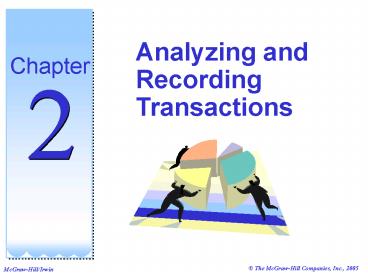Analyzing and Recording Transactions - PowerPoint PPT Presentation
1 / 36
Title:
Analyzing and Recording Transactions
Description:
Double ... Journalizing and Posting Transactions. Step 1: Analyze transactions and ... Double entry: 101. 301. Posting: The McGraw-Hill Companies, Inc., 2005 ... – PowerPoint PPT presentation
Number of Views:113
Avg rating:3.0/5.0
Title: Analyzing and Recording Transactions
1
Analyzing and Recording Transactions
Chapter
2
2
Analyzing and Recording Process
- Exchanges of economic consideration between two
parties.
External Transactions occur between the
organization and an outside party.
Internal Transactions occur within the
organization.
3
Analyzing and Recording Process
4
Source Documents
Bills from Suppliers
Checks
Purchase Orders
Employee EarningsRecord
Bank Statement
Sales Tickets
5
The Account and its Analysis
An account is a record of increases and decreases
in a specific asset, liability, equity, revenue,
or expense item.
The general ledger is a record containing all
accounts used by the company.
6
The Account and its Analysis
LiabilitiesAccounts
EquityAccounts
AssetsAccounts
7
Asset Accounts
Cash
Accounts Receivable
Land
AssetAccounts
Notes Receivable
Buildings
Prepaid Accounts
Equipment
Supplies
8
Liability Accounts
Notes Payable
Accounts Payable
LiabilityAccounts
Unearned Revenues
Accrued Liabilities
9
Equity Accounts
Owners Capital
Owners Withdrawals
EquityAccounts
Revenues
Expenses
10
The Account and its Analysis
Liabilities
Equity
Assets
11
Debits and Credits
- A T-account represents a ledger account and is a
tool used to understand the effects of one or
more transactions.
12
Double-Entry Accounting
13
Double-Entry Accounting
Exh. 3.8
Equity
14
Double-Entry Accounting
- An account balance is the difference between the
increases and decreases in an account.
15
Journalizing and Posting Transactions
16
Journalizing Transactions
17
Balance Column Account
- T-accounts are useful illustrations, but balance
column ledger accounts are used in practice.
18
Posting Journal Entries
1
Identify the account.
19
Posting Journal Entries
Enter the date.
2
20
Posting Journal Entries
3
Enter the amount and description.
21
Posting Journal Entries
4
Enter the journal reference.
22
Posting Journal Entries
Compute the balance.
5
23
Posting Journal Entries
6
Enter the ledger reference.
24
Analyzing Transactions An Illustration
25
Analyzing Transactions An Illustration
26
Analyzing Transactions An Illustration
27
Analyzing Transactions An Illustration
28
Analyzing Transactions An Illustration
29
After processing its remaining transactions for
December, FastForwards Trial Balance is prepared.
30
Searching for and Correcting Errors
If the trial balance does not balance, the
error(s) must be found and corrected.
?Make sure the trial balance columns are
correctly added.
?Recompute each account balance in the ledger.
?Make sure account balances are correctly entered
into the ledger.
?Verify that each journal entry is posted
correctly.
?See if debit or credit accounts are mistakenly
placed on the trial balance.
?Verify that each original journal entry has
equal debits and credits.
31
Using a Trial Balance to Prepare Financial
Statements
Point inTime
Point inTime
Period of Time
Income Statement
Statement of Owners Equity
Income Statement of Cash Flows
Beginning Balance Sheet
Ending Balance Sheet
32
Income Statement
33
Statement of Owners Equity
34
Balance Sheet
35
Debt Ratio
- Describes the relationship between the amounts of
the companys liabilities and assets. - Helps to assess the risk that a company will fail
to pay its debts.
36
End of Chapter 2































